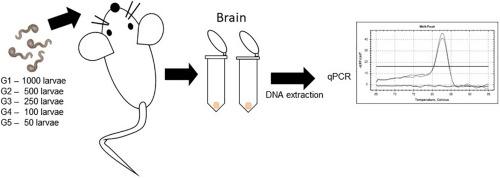Parasitology International ( IF 1.9 ) Pub Date : 2020-05-13 , DOI: 10.1016/j.parint.2020.102134 Micaele Quintana de Moura 1 , Wesley Douglas da Silva Terto 1 , Luciana Farias da Costa Avila 2 , Vinicius Farias Campos 3 , William Borges Domingues 3 , Natália Berne Pinheiro 1 , Gabriela de Almeida Capella 1 , Adriane Leites Strothmann 1 , Carlos James Scaini 2 , Maria Elisabeth Aires Berne 1

|
The nematode Toxocara canis is of public health importance and is the main causative agent of toxocariasis in humans. This disease is difficult to diagnose due to several factors, including the possibility of cross-reactions with other nematodes in the ELISA. To overcome this problem, molecular tests have been recommended as an alternative to identify the parasite. The quantitative real-time polymerase chain reaction (qPCR) technique was used in this study to identify and quantify the parasite load of T. canis in the mouse brain. To this end, 24 mice were divided into six groups, five of which were challenged with different infective doses of T. canis larvae (L3) (1000, 500, 250, 100 and 50 larvae), while the sixth group, uninfected, acted as negative control. Forty-five days after infection, the animals were euthanized to collect the brain, from which two portions of 20 mg of tissue were taken for DNA extraction, while the rest of the brain tissue was digested to quantify the number of larvae by microscopy. The number of DNA copies was calculated from the standard DNA quantification curve, showing values of E = 93.4%, R2 = 0.9655 and Y = −3.415. A strong positive correlation (R = 0, 81; p < .001) was found between the number of copies and the recovery of larvae from brain. However, the parasite's DNA was also identified even in animals from whose brain no larvae were recovered after tissue digestion. The results of this study therefore confirm that the qPCR technique can be a valuable tool for the detection and quantification of T. canis DNA in murine hosts, even in animals whose with tissues contain very few parasites.
中文翻译:

通过qPCR在接种不同感染剂量的小鼠中定量犬弓形虫DNA。
线虫Toxocara canis具有重要的公共卫生意义,是人类弓形虫病的主要诱因。由于多种因素,这种疾病难以诊断,包括与ELISA中其他线虫发生交叉反应的可能性。为了克服这个问题,建议使用分子检测作为鉴定寄生虫的替代方法。定量实时聚合酶链反应(qPCR)技术用于本研究中,以鉴定和定量小鼠脑中犬圆弧菌的寄生虫负荷。为此,将24只小鼠分为六组,其中五组分别接受不同感染剂量的犬圆弧菌攻击。幼虫(L3)(1000、500、250、100和50个幼虫),而第六组未感染,作为阴性对照。感染后四十五天,对动物实施安乐死以收集大脑,然后从其中抽取20毫克组织的两部分进行DNA提取,同时消化其余的大脑组织,以通过显微镜检查定量幼虫的数量。从标准DNA定量曲线计算DNA拷贝数,显示E = 93.4%,R2 = 0.9655和Y = -3.415。强正相关(R = 0,81; p <0.001)被发现之间的副本数和幼虫从大脑中恢复。但是,即使在组织消化后没有发现幼虫的动物中,也能鉴定出该寄生虫的DNA。因此,这项研究的结果证实,qPCR技术可以成为检测和定量鼠宿主中犬毛小球菌DNA的有价值的工具,即使在组织中含有很少寄生虫的动物中也是如此。



























 京公网安备 11010802027423号
京公网安备 11010802027423号